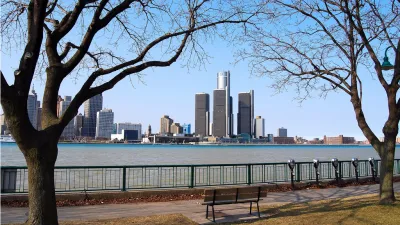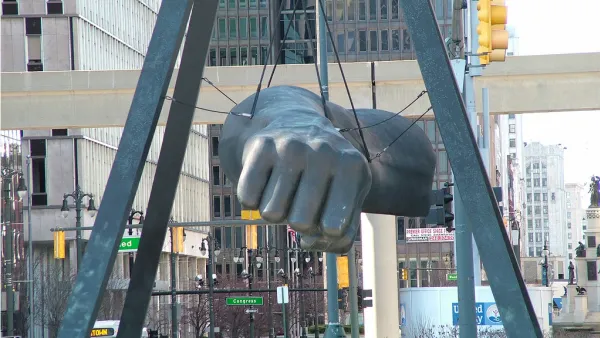One of the scariest things about Detroit's bankruptcy proceedings is that the fiscal choices that city made has been repeated in many other cities.

By now, you’ve probably heard that Detroit has filed bankruptcy. You may have also heard about Detroit trying to shut off water to nearly 10 percent of its population or municipal pensioners fighting to save their pensions or various foundations saving Detroit’s art collection from creditors or various creditors trying to stop the bankruptcy filing in court. You are even excused for asking: “What does it mean when a city files bankruptcy anyway?” Don’t worry. You are in good company. No one truly knows what happens when a city as large as Detroit files bankruptcy.
If the bankruptcy filing is allowed to succeed, Detroit, which has $18,000,000,000 (written out for dramatic effect) in debt, or nearly $300,000 of debt for every resident, will be allowed to devote its scarce tax revenue to providing essential services instead of paying debt service to creditors. The experts (politicians, urban planners, and economists) are still unsure if the bankruptcy will put the city on stable footing. Current tax revenue has been unable to sustain the current expenditures exclusive of debt service, such as public safety, education, or health care. There is no reason to believe the city's fiscal condition will be different in the near future.
If the city is not allowed to file bankruptcy, then an even more dire situation will occur. Locked out of municipal market and access to further debt, the city will need to slash municipal expenditures even further. The "D"—already known to be a tough city—may become truly unlivable.
Most importantly, the current municipal disaster in Detroit and consequent negative impact on households is not unique. Detroit is the tip of the iceberg! The municipal finances of many older American cities, including Newark, Chicago, Harrisburg, and others, represent a ticking time bomb. These cities are simply unable to sustain their current expense structures. All residents expect their cities to pay for public safety in the form of a robust police force, public health in the form of professional hospitals and clinics, a supply of clean water for all residents, and healthy pensions for former municipal workers. These expenses have simply become unsustainable for many cities. Just like someone who bought nice clothes and a car on credit and is forced to return those items when they are unable to pay the credit card company, these cities can no longer borrow and are now forced to cancel or lessen certain expenses.
How did this happen? Don’t we live in the wealthiest country in the world?
There exist a direct correlation between cities with failing municipal finances and cities that have lost substantial population in the past few decades. Again, Detroit is a prime example but not the only one. Large cities primarily in the Northeast and Midwest, such as Newark, Cleveland, and Baltimore, suffer from the same fate. In 1950, Detroit had nearly 2,000,000 residents. Today, Detroit has less than 800,000 residents, and the number continues to decline. Residents pay taxes. Fewer residents means less tax revenue generated for Detroit to pay for essential services such as police, education, health care, or even water. If you’ve had a friend or family member who had a great job and nice house and the lost their job or had to accept a job making less money, you would tell your friend to move into a smaller house and give up their nice car.
So how does Detroit move into a smaller house? And how do they change in responsible way that doesn’t impact essential service to poor residents? One way to do so is through planned shrinkage. Planned shrinkage is a policy that involves lessening the municipal footprint of a city by relocating tenants away from more blighted neighborhoods and concentrating municipal services into more dense yet fewer neighborhoods. The implementation of planned shrinkage can and should be used for any city that faces lower tax revenue due to diminishing population. In essence, residents are encouraged to leave certain blighted communities to live in other, more thriving communities.
A blighted neighborhood is one that has vacant infrastructure such as vacant homes, vacant schools, or decaying sewer system. Although this infrastructure was used at one time, cities that suffer from a consistent decreasing population would naturally experience blighted neighborhoods. However, blighted neighborhoods still cost money to administer. Fewer neighborhoods and a smaller footprint for the city result in savings on sewer systems, public safety, education, and health care. Planned shrinkage allows the city to focus its scarce tax revenue on providing essential services and eliminate wasteful expenditures due to the upkeep of unneeded infrastructure. If the average American understands that tough times may cause a household to downsize to smaller house or an apartment, then why can’t this work for a city?
You may be thinking that encouraging tenants to leave their neighborhood is neither very humane nor compassionate. Really? Is shutting off water to 46,000 households and arguably some of the poorest residents in Detroit humane? The United Nations Office of Human Rights recently commented that Detroit was violating international standards by shutting water off. You read that correctly. The United Nations was not criticizing some distant country in Africa or Southeast Asia. It was criticizing the United States for its inaction in response to Detroit.
American capitalism is failing Detroit. Capitalism works well to promote growth but is unable to humanely address cities in decline. Planned shrinkage and other interventionist policies are needed to stop an impending crisis in Detroit and to reverse this disturbing trend in other cities.

National Parks Layoffs Will Cause Communities to Lose Billions
Thousands of essential park workers were laid off this week, just before the busy spring break season.

Retro-silient?: America’s First “Eco-burb,” The Woodlands Turns 50
A master-planned community north of Houston offers lessons on green infrastructure and resilient design, but falls short of its founder’s lofty affordability and walkability goals.

Delivering for America Plan Will Downgrade Mail Service in at Least 49.5 Percent of Zip Codes
Republican and Democrat lawmakers criticize the plan for its disproportionate negative impact on rural communities.

Test News Post 1
This is a summary

Test News Headline 46
Test for the image on the front page.

Balancing Bombs and Butterflies: How the National Guard Protects a Rare Species
The National Guard at Fort Indiantown Gap uses GIS technology and land management strategies to balance military training with conservation efforts, ensuring the survival of the rare eastern regal fritillary butterfly.
Urban Design for Planners 1: Software Tools
This six-course series explores essential urban design concepts using open source software and equips planners with the tools they need to participate fully in the urban design process.
Planning for Universal Design
Learn the tools for implementing Universal Design in planning regulations.
EMC Planning Group, Inc.
Planetizen
Planetizen
Mpact (formerly Rail~Volution)
Great Falls Development Authority, Inc.
HUDs Office of Policy Development and Research
NYU Wagner Graduate School of Public Service





























